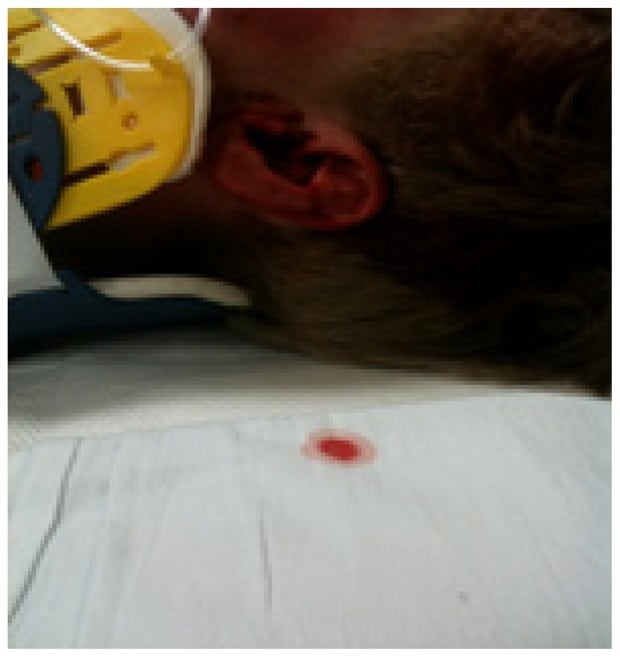| Author | Affiliation |
|---|---|
| Danielle D. Campagne, MD | University of California, San Francisco-Fresno, Department of Emergency Medicine, Fresno, California |
| Saleen Manternach, MD | University of California, San Francisco-Fresno, Department of Emergency Medicine, Fresno, California |
A restrained 20 year old male driver presents after a rollover motor vehicle collision. He is repetitive after sustaining a loss of consciousness, but is a Glasco Coma Scale of 15 on arrival. He is complaining of left ear and shoulder pain. He has no focal findings other than a ruptured left tympanic membrane (Figure).
A “halo” or “ring” sign, occurs when cerebrospinal fluid (CSF) mixes with blood on an absorbent surface. The blood forms a spot in the center and a lightly stained ring forms a halo around it. The halo sign is reliable for detecting CSF but not exclusive.2 Saline and water, can also form a halo sign when mixed with blood. In the setting of trauma, the halo sign may represent a basilar skull fracture. An aspirate of the fluid can be analyzed for CSF confirmation. Glucose is the usual screening test for CSF detection; however, false positives are common in diabetic patients.3 Beta-2-tranferrin, a protein found only in CSF, perilymph and aqueous humor,4 is a more reliable biomarker for CSF leakage. It is detectable outside the body for up to 7 days regardless of storage at room temperature or exposure to nasal mucosa.3
Our patient’s computerized tomography scan head and c-spine were negative for injury. The persistent fluid from his ear was positive for B-2-transferrin – confirming a CSF leak. He was admitted and observed without any further intervention.
Footnotes
Full text available through open access at http://escholarship.org/uc/uciem_westjem
Address for Correspondence: Danielle D. Campagne, MD, UCSF-Fresno, 155 N. Fresno St, Ste 206, Fresno, CA 93710. Email: dcampagne@fresno.ucsf.edu 7 / 2014; 15:363 – 363
Submission history: Revision received January 21, 2014; Submitted February 10, 2014; Accepted April 2, 2014
Conflicts of Interest: By the WestJEM article submission agreement, all authors are required to disclose all affiliations, funding sources and financial or management relationships that could be perceived as potential sources of bias. The authors disclosed none.
REFERENCES
1 Beckhardt RN, Setzen M, Carras R Primary spontaneous cerebrospinal fluid rhinorrhea. Otolaryngology – Head & Neck Surgery. 1991; 104:425-32
2 Dula DJ, Fales W The ‘ring sign’: is it a reliable indicator for cerebral spinal fluid?. Ann Emerg Med. 1993; 22:718-20
3 Mantur M, Lukaszweicz-Zajac M Cerebrospinal fluid leakage–reliable diagnostic methods. Clin Chim Acta. 2011; 12;412:837-40
4 Skedros DG, Cass SP, Hirsch BE Beta-2 transferrin assay in clinical management of cerebral spinal fluid and perilymphatic fluid leaks”. Oct. 1991; 22:341-4



